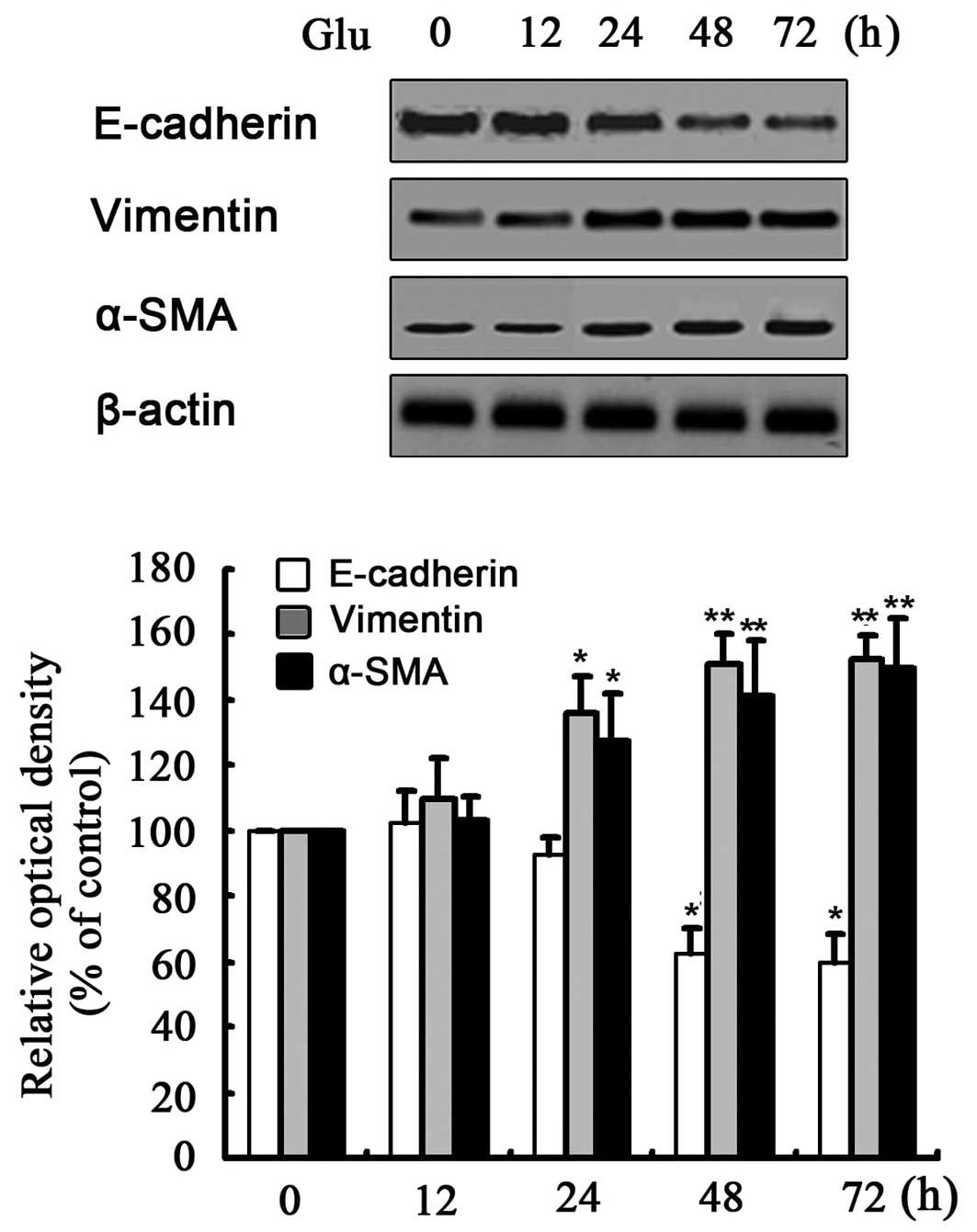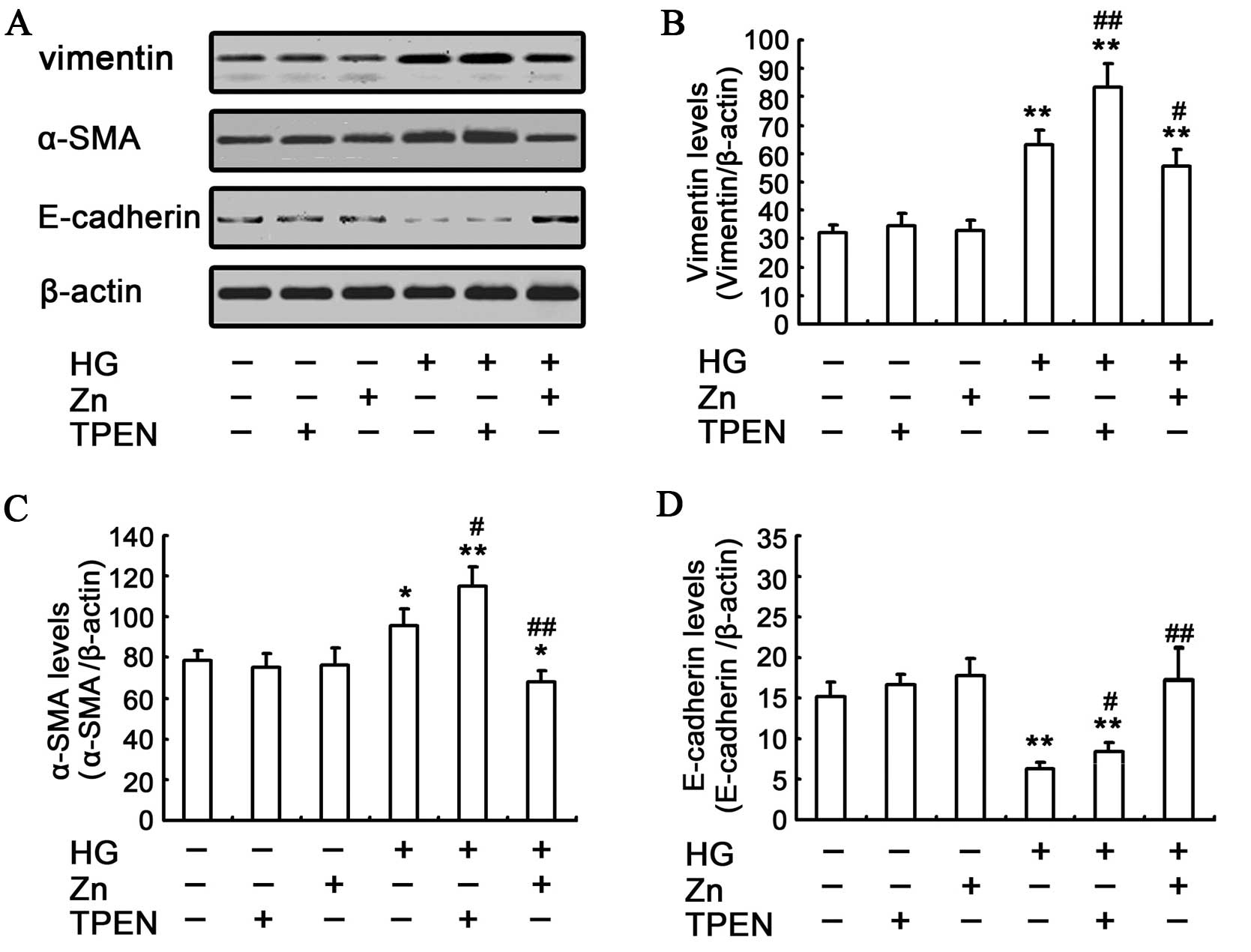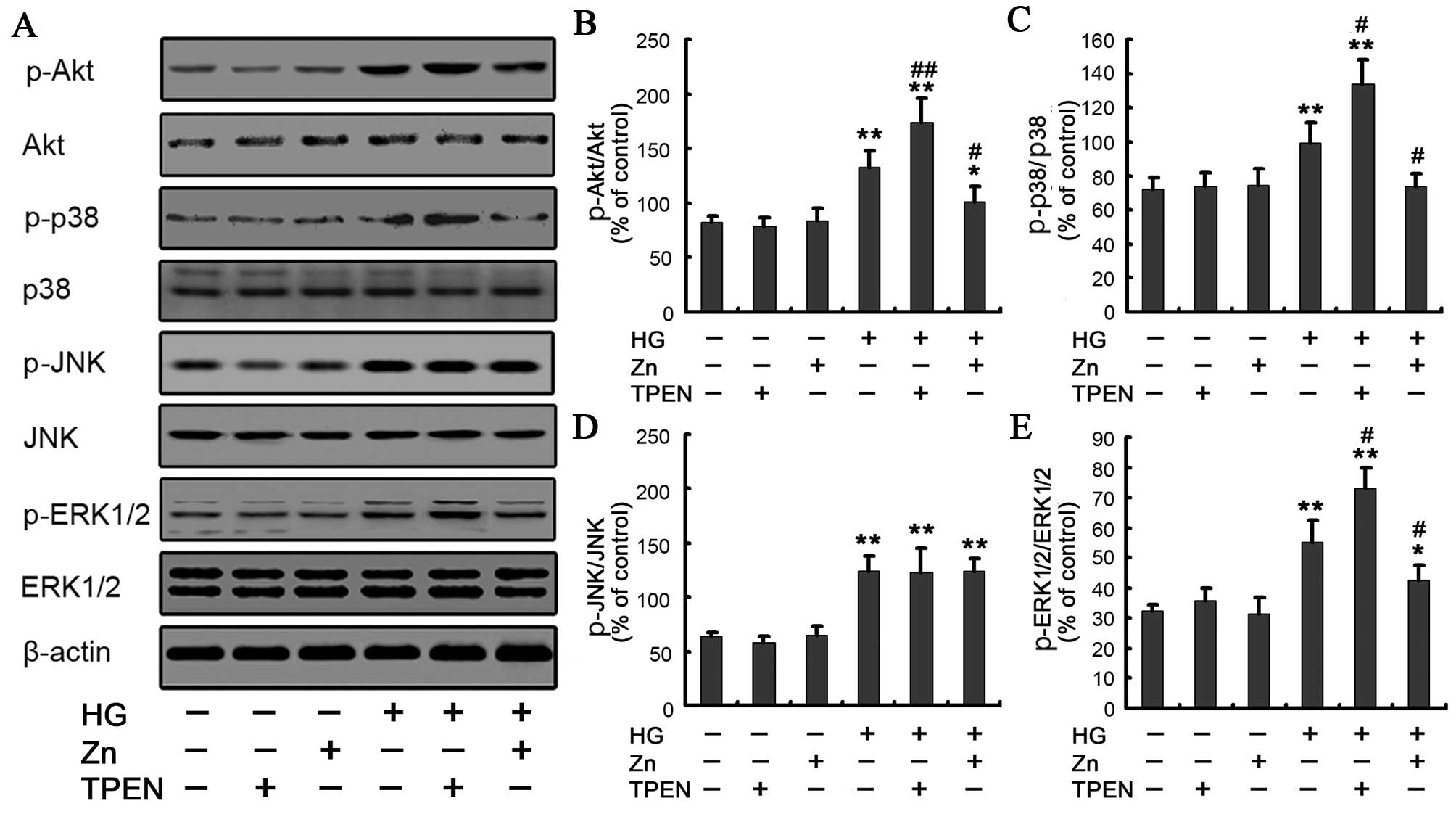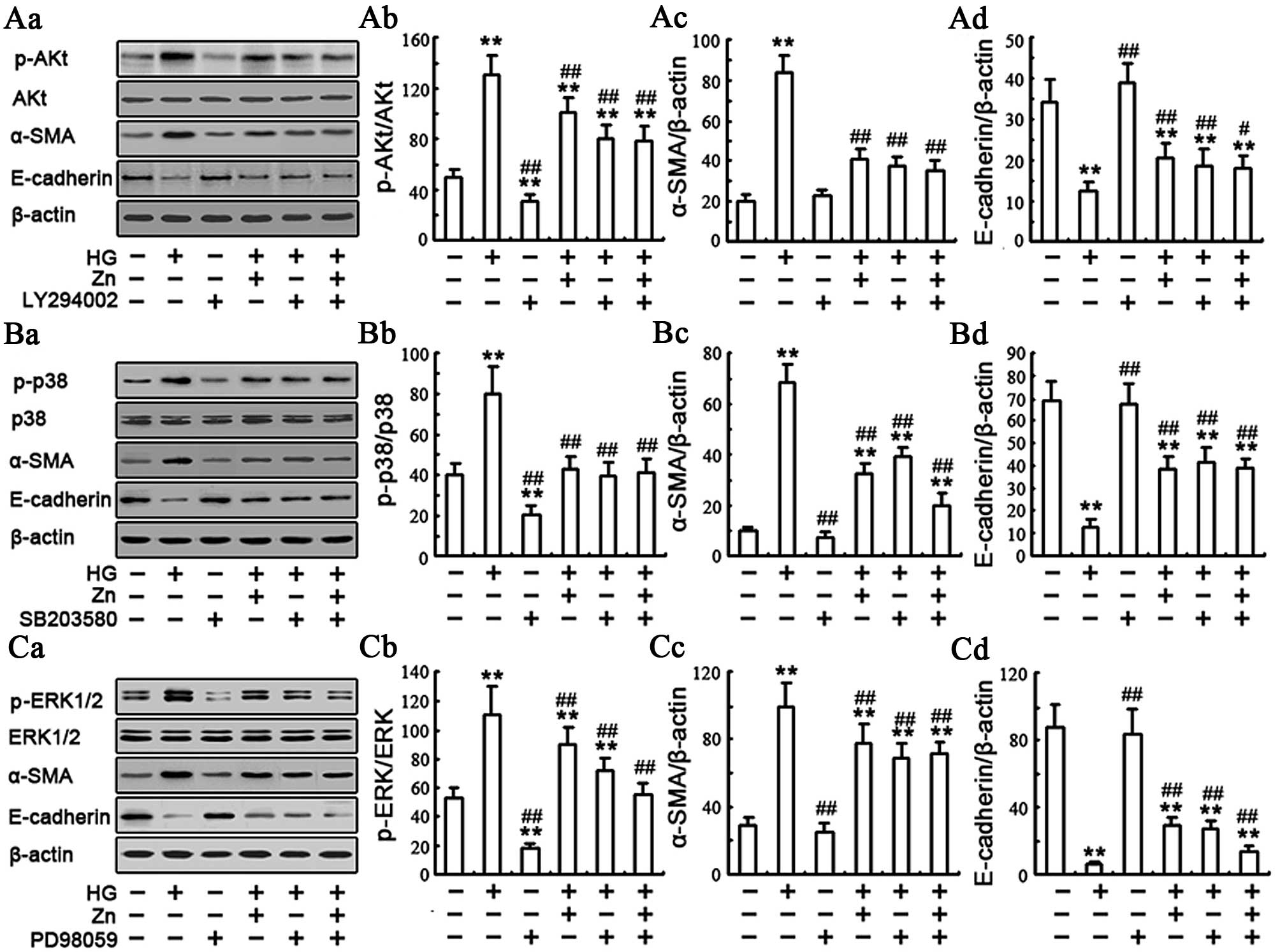|
1
|
Schena FP and Gesualdo L: Pathogenetic
mechanisms of diabetic nephropathy. J Am Soc Nephrol. 16(Suppl 1):
S30–S33. 2005. View Article : Google Scholar : PubMed/NCBI
|
|
2
|
Lapice E, Pinelli M, Riccardi G, et al:
Pro12Ala polymorphism in the PPARG gene contributes to the
development of diabetic nephropathy in Chinese type 2 diabetic
patients: comment on the study by Liu et al. Diabetes Care.
33:e1142010. View Article : Google Scholar : PubMed/NCBI
|
|
3
|
Ayodele OE, Alebiosu CO and Salako BL:
Diabetic nephropathy - a review of the natural history, burden,
risk factors and treatment. J Natl Med Assoc. 96:1445–1454.
2004.PubMed/NCBI
|
|
4
|
Yeh CH, Chang CK, Cheng KC, et al: Role of
bone morphogenetic proteins-7 (BMP-7) in the renal improvement
effect of DangGui (Angelica sinensis) in type-1 diabetic rats. Evid
Based Complement Alternat Med. 2011:7967232011. View Article : Google Scholar : PubMed/NCBI
|
|
5
|
Gilbert RE and Cooper ME: The
tubulointerstitium in progressive diabetic kidney disease: more
than an aftermath of glomerular injury? Kidney Int. 56:1627–1637.
1999. View Article : Google Scholar : PubMed/NCBI
|
|
6
|
Simonson MS: Phenotypic transitions and
fibrosis in diabetic nephropathy. Kidney Int. 71:846–854. 2007.
View Article : Google Scholar : PubMed/NCBI
|
|
7
|
Burns WC, Twigg SM, Forbes JM, et al:
Connective tissue growth factor plays an important role in advanced
glycation end product-induced tubular epithelial-to-mesenchymal
transition: implications for diabetic renal disease. J Am Soc
Nephrol. 17:2484–2494. 2006. View Article : Google Scholar : PubMed/NCBI
|
|
8
|
Lv ZM, Wang Q, Wan Q, et al: The role of
the p38 MAPK signaling pathway in high glucose-induced
epithelial-mesenchymal transition of cultured human renal tubular
epithelial cells. PLoS One. 6:e228062011. View Article : Google Scholar : PubMed/NCBI
|
|
9
|
Lee YJ and Han HJ: Troglitazone
ameliorates high glucose-induced EMT and dysfunction of SGLTs
through PI3K/Akt, GSK-3beta, Snail1, and beta-catenin in renal
proximal tubule cells. Am J Physiol Renal Physiol. 298:F1263–F1275.
2009. View Article : Google Scholar
|
|
10
|
Karatug A, Kaptan E, Bolkent S, et al:
Alterations in kidney tissue following zinc supplementation to
STZ-induced diabetic rats. J Trace Elem Med Biol. 27:52–57. 2012.
View Article : Google Scholar : PubMed/NCBI
|
|
11
|
Dogukan A, Sahin N, Tuzcu M, et al: The
effects of chromium histidinate on mineral status of serum and
tissue in fat-fed and streptozotocin-treated type II diabetic rats.
Biol Trace Elem Res. 131:124–132. 2009. View Article : Google Scholar : PubMed/NCBI
|
|
12
|
Simonian MH and Smith JA:
Spectrophotometric and colori-metric determination of protein
concentration. Curr Protoc Mol Biol. Chapter 10: Unit 10.1A. 2006.
View Article : Google Scholar
|
|
13
|
Kalluri R and Neilson EG:
Epithelial-mesenchymal transition and its implications for
fibrosis. J Clin Invest. 112:1776–1784. 2003. View Article : Google Scholar : PubMed/NCBI
|
|
14
|
Zeisberg M and Kalluri R: The role of
epithelial-to-mesenchymal transition in renal fibrosis. J Mol Med
(Berl). 82:175–181. 2004. View Article : Google Scholar
|
|
15
|
Sato M, Muragaki Y, Saika S, et al:
Targeted disruption of TGF-beta1/Smad3 signaling protects against
renal tubulointerstitial fibrosis induced by unilateral ureteral
obstruction. J Clin Invest. 112:1486–1494. 2003. View Article : Google Scholar : PubMed/NCBI
|
|
16
|
Hills CE and Squires PE: TGF-beta1-induced
epithelial-to-mesenchymal transition and therapeutic intervention
in diabetic nephropathy. Am J Nephrol. 31:68–74. 2010. View Article : Google Scholar
|
|
17
|
Hills CE and Brunskill NJ: Intracellular
signalling by C-peptide. Exp Diabetes Res. 2008:6351582008.
View Article : Google Scholar : PubMed/NCBI
|
|
18
|
Takahashi M, Saito H, Higashimoto M, et
al: Possible inhibitory effect of oral zinc supplementation on
hepatic fibrosis through downregulation of TIMP-1: a pilot study.
Hepatol Res. 37:405–409. 2007. View Article : Google Scholar : PubMed/NCBI
|
|
19
|
Wang L, Zhou Z, Saari JT, et al:
Alcohol-induced myocardial fibrosis in metallothioneinnull mice:
prevention by zinc supplementation. Am J Pathol. 167:337–344. 2005.
View Article : Google Scholar : PubMed/NCBI
|
|
20
|
Gandhi MS, Deshmukh PA, Kamalov G, et al:
Causes and consequences of zinc dyshomeostasis in rats with chronic
aldosteronism. J Cardiovasc Pharmacol. 52:245–252. 2008. View Article : Google Scholar : PubMed/NCBI
|
|
21
|
Van Biervliet S, Vande Velde S, Van
Biervliet JP, et al: The effect of zinc supplements in cystic
fibrosis patients. Ann Nutr Metab. 52:152–156. 2008. View Article : Google Scholar : PubMed/NCBI
|
|
22
|
Zhang X, Liang D, Guo B, et al: Zinc
inhibits high glucose-induced apoptosis in peritoneal mesothelial
cells. Biol Trace Elem Res. 150:424–432. 2012. View Article : Google Scholar : PubMed/NCBI
|
|
23
|
Mossman BT: In vitro approaches for
determining mechanisms of toxicity and carcinogenicity by asbestos
in the gastrointestinal and respiratory tracts. Environ Health
Perspect. 53:155–161. 1983. View Article : Google Scholar : PubMed/NCBI
|
|
24
|
Rhyu DY, Yang Y, Ha H, et al: Role of
reactive oxygen species in TGF-beta1-induced mitogen-activated
protein kinase activation and epithelial-mesenchymal transition in
renal tubular epithelial cells. J Am Soc Nephrol. 16:667–675. 2005.
View Article : Google Scholar : PubMed/NCBI
|
|
25
|
Yang J and Liu Y: Dissection of key events
in tubular epithelial to myofibroblast transition and its
implications in renal interstitial fibrosis. Am J Pathol.
159:1465–1475. 2001. View Article : Google Scholar : PubMed/NCBI
|
|
26
|
Ha H and Lee HB: Reactive oxygen species
and matrix remodeling in diabetic kidney. J Am Soc Nephrol.
14:S246–S249. 2003. View Article : Google Scholar : PubMed/NCBI
|
|
27
|
Zeng R, Yao Y, Han M, et al: Biliverdin
reductase mediates hypoxia-induced EMT via PI3-kinase and Akt. J Am
Soc Nephrol. 19:380–387. 2008. View Article : Google Scholar : PubMed/NCBI
|
|
28
|
Boca M, D’Amato L, Distefano G, et al:
Polycystin-1 induces cell migration by regulating
phosphatidylinositol 3-kinase-dependent cytoskeletal rearrangements
and GSK3beta-dependent cell cell mechanical adhesion. Mol Biol
Cell. 18:4050–4061. 2007. View Article : Google Scholar : PubMed/NCBI
|
|
29
|
Liu Q, Mao H, Nie J, et al: Transforming
growth factor {beta}1 induces epithelial-mesenchymal transition by
activating the JNK-Smad3 pathway in rat peritoneal mesothelial
cells. Perit Dial Int. 28(Suppl 3): S88–S95. 2008.PubMed/NCBI
|
|
30
|
Yang F, Chung AC, Huang XR, et al:
Angiotensin II induces connective tissue growth factor and collagen
I expression via transforming growth factor-beta-dependent and
-independent Smad pathways: the role of Smad3. Hypertension.
54:877–884. 2009. View Article : Google Scholar : PubMed/NCBI
|
|
31
|
Yamashita M, Fatyol K, Jin C, et al: TRAF6
mediates Smad-independent activation of JNK and p38 by TGF-beta.
Mol Cell. 31:918–924. 2008. View Article : Google Scholar : PubMed/NCBI
|
|
32
|
von Bulow V, Dubben S, Engelhardt G, et
al: Zinc-dependent suppression of TNF-alpha production is mediated
by protein kinase A-induced inhibition of Raf-1, I kappa B kinase
beta, and NF-kappa B. J Immunol. 179:4180–4186. 2007. View Article : Google Scholar : PubMed/NCBI
|
|
33
|
Bao S and Knoell DL: Zinc modulates
cytokine-induced lung epithelial cell barrier permeability. Am J
Physiol Lung Cell Mol Physiol. 291:L1132–L1141. 2006. View Article : Google Scholar : PubMed/NCBI
|
|
34
|
Mengheri E, Nobili F, Vignolini F, et al:
Bifidobacterium animalis protects intestine from damage induced by
zinc deficiency in rats. J Nutr. 129:2251–2257. 1999.PubMed/NCBI
|
|
35
|
Wang X, Pan X and Song J: AMP-activated
protein kinase is required for induction of apoptosis and
epithelial-to-mesenchymal transition. Cell Signal. 22:1790–1797.
2010. View Article : Google Scholar : PubMed/NCBI
|
|
36
|
Lan HY: Tubular epithelial-myofibroblast
transdifferentiation mechanisms in proximal tubule cells. Curr Opin
Nephrol Hypertens. 12:25–29. 2003. View Article : Google Scholar
|
|
37
|
Corniola RS, Tassabehji NM, Hare J, et al:
Zinc deficiency impairs neuronal precursor cell proliferation and
induces apoptosis via p53-mediated mechanisms. Brain Res.
1237:52–61. 2008. View Article : Google Scholar : PubMed/NCBI
|
|
38
|
Yamaguchi M and Kishi S: Differential
effects of transforming growth factor-beta on osteoclast-like cell
formation in mouse marrow culture: relation to the effect of
zinc-chelating dipeptides. Peptides. 16:1483–1488. 1995. View Article : Google Scholar : PubMed/NCBI
|
|
39
|
Szuster-Ciesielska A, Plewka K, Daniluk J,
et al: Zinc supplementation attenuates ethanol- and
acetaldehyde-induced liver stellate cell activation by inhibiting
reactive oxygen species (ROS) production and by influencing
intracellular signaling. Biochem Pharmacol. 78:301–314. 2009.
View Article : Google Scholar : PubMed/NCBI
|
|
40
|
Prasad AS: Clinical, immunological,
anti-inflammatory and antioxidant roles of zinc. Exp Gerontol.
43:370–377. 2008. View Article : Google Scholar
|
|
41
|
Ho E and Ames BN: Low intracellular zinc
induces oxidative DNA damage, disrupts p53, NFkappa B, and AP1 DNA
binding, and affects DNA repair in a rat glioma cell line. Proc
Natl Acad Sci USA. 99:16770–16775. 2002. View Article : Google Scholar : PubMed/NCBI
|
|
42
|
Zhang X, Liang D, Guo B, et al: Zinc
transporter 5 and zinc transporter 7 induced by high glucose
protects peritoneal mesothelial cells from undergoing apoptosis.
Cell Signal. 25:999–1010. 2013. View Article : Google Scholar : PubMed/NCBI
|
|
43
|
Kosugi T and Sato W: Midkine and the
kidney: health and diseases. Nephrol Dial Transplant. 27:16–21.
2012. View Article : Google Scholar
|
|
44
|
Agarwal E, Brattain MG and Chowdhury S:
Cell survival and metastasis regulation by Akt signaling in
colorectal cancer. Cell Signal. 25:1711–1719. 2013. View Article : Google Scholar : PubMed/NCBI
|
|
45
|
Kattla JJ, Carew RM, Heljic M, et al:
Protein kinase B/Akt activity is involved in renal TGF-beta1-driven
epithelial-mesenchymal transition in vitro and in vivo. Am J
Physiol Renal Physiol. 295:215–225. 2008. View Article : Google Scholar
|
|
46
|
Pallet N, Thervet E and Anglicheau D:
c-Jun-N-terminal kinase signaling is involved in
cyclosporine-induced epithelial phenotypic changes. J Transplant.
2012:3486042012.
|














